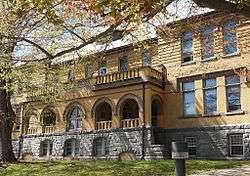Broad Street School
The Broad Street School is a historic former school building at 100 Broad Street in Norwich, Connecticut. The school was designed by New York City architect Wilson Potter and built in 1897. It is a well-executed and well-preserved example of Romanesque styling, and was the largest school built as part of a major construction program by the city.[2] The schoolhouse was listed on the National Register of Historic Places on January 19, 1984.[1] It has been converted to residential use.
Broad Street School | |
 | |
  | |
| Location | 100 Broad Street, Norwich, Connecticut |
|---|---|
| Coordinates | 41°32′5″N 72°4′35″W |
| Area | 0.8 acres (0.32 ha) |
| Built | 1897 |
| Architect | Potter, Wilson |
| Architectural style | Romanesque |
| Part of | Chelsea Parade Historic District (ID88003215) |
| NRHP reference No. | 84001162[1] |
| Significant dates | |
| Added to NRHP | January 19, 1984 |
| Designated CP | May 12, 1989 |
Description and history
The Broad Street School building is located in a residential area north of downtown Norwich, on a lot bounded on the north by Rockwell Street and the south by Broad Street. It is a two-story masonry structure, with a granite foundation, yellow brick exterior with trim elements of brown brick and granite, and slate hip roof. It is T-shaped in layout, with a central block flanked by slightly projecting wings, and a projecting section at the rear. The central block facade is fronted by a project porch with an arcade of round-arch openings topped by a low balustrade. The arches are finished in brown brick, with a brick stringcourse separating the arches from the porch eave.[2]
The school was built in 1897 to a design by Wilson Potter, a well-known New York City architect who had already executed several commissions for Connecticut school districts. The building's relatively high-style architecture is probably due in part to its placement in what was at the time Norwich's elite residential neighborhood. The school exemplified state-of-the-art thinking about school buildings, providing high ceilings with well-lit classrooms, facilities segregated by grade and sex, and indoor plumbing. The school was among those featured in a state education commissioner's report in 1902.[2] The school close in the late 1970s, and has been converted to residential use.
References
- "National Register Information System". National Register of Historic Places. National Park Service. March 13, 2009.
- Matthew Roth; Bruce Clouette & John Herzan (September 28, 1983). "National Register of Historic Places Inventory/Nomination: Broad Street School". National Park Service. and accompanying photos